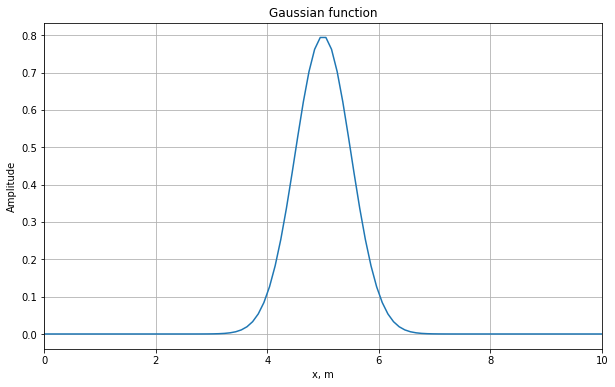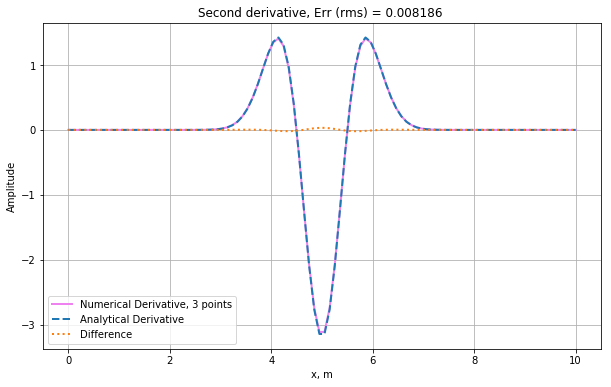Code
# Import Libraries
import numpy as np
from math import *
import matplotlib.pyplot as pltNote: * Loop boundaries changed for 5-point operator, May 2020
We initialize a Gaussian function
\[\begin{equation} f(x)=\dfrac{1}{\sqrt{2 \pi a}}e^{-\dfrac{(x-x_0)^2}{2a}} \end{equation}\]
Note that this specific definition is a \(\delta-\)generating function. This means that \(\int{f(x) dx}=1\) and in the limit \(a\rightarrow0\) the function f(x) converges to a \(\delta-\)function.
# Initialization
xmax=10.0 # physical domain (m)
nx=100 # number of space samples
a=.25 # exponent of Gaussian function
dx=xmax/(nx-1) # Grid spacing dx (m)
x0 = xmax/2 # Center of Gaussian function x0 (m)
x=np.linspace(0,xmax,nx) # defining space variable
# Initialization of Gaussian function
f=(1./sqrt(2*pi*a))*np.exp(-(((x-x0)**2)/(2*a)))
Now let us calculate the second derivative using the finite-difference operator with three points
\[\begin{equation} f^{\prime\prime}_{num}(x)=\dfrac{f(x+dx)-2 f(x)+f(x-dx)}{dx^2} \end{equation}\]
and compare it with the analytical solution \[\begin{equation} f^{\prime\prime}(x)= \dfrac{1}{\sqrt{2\pi a}} ( \dfrac{(x-x_0)^2}{a^2}- \dfrac{1}{a} ) \ e^{-\dfrac{(x-x_0)^2}{2a}} \end{equation}\]
# Second derivative with three-point operator
# Initiation of numerical and analytical derivatives
nder3=np.zeros(nx) # numerical derivative
ader=np.zeros(nx) # analytical derivative
# Numerical second derivative of the given function
for i in range (1, nx-1):
nder3[i]=(f[i+1] - 2*f[i] + f[i-1])/(dx**2)
# Analytical second derivative of the Gaissian function
ader=1./sqrt(2*pi*a)*((x-x0)**2/a**2 -1/a)*np.exp(-1/(2*a)*(x-x0)**2)
# Exclude boundaries
ader[0]=0.
ader[nx-1]=0.
# Calculate rms error of numerical derivative
rms = np.sqrt(np.mean((nder3-ader)**2))# Plotting
plt.figure(figsize=(10,6))
plt.plot (x, nder3,label="Numerical Derivative, 3 points", lw=2, color="violet")
plt.plot (x, ader, label="Analytical Derivative", lw=2, ls="--")
plt.plot (x, nder3-ader, label="Difference", lw=2, ls=":")
plt.title("Second derivative, Err (rms) = %.6f " % (rms) )
plt.xlabel('x, m')
plt.ylabel('Amplitude')
plt.legend(loc='lower left')
plt.grid()
plt.show()
In the cell below calculation of the second derivative with five points is provided with the following weights:
\[\begin{equation} f^{\prime\prime}(x)=\dfrac{-\dfrac{1}{12}f(x-2dx)+\dfrac{4}{3}f(x-dx)-\dfrac{5}{2}f(x) +\dfrac{4}{3}f(x+dx)-\dfrac{1}{12}f(x+2dx)}{dx^2} \end{equation}\]
# First derivative with four points
# Initialisation of derivative
nder5=np.zeros(nx)
# Calculation of 2nd derivative
for i in range (2, nx-2):
nder5[i] = (-1./12 * f[i - 2] + 4./3 * f[i - 1] - 5./2 * f[i] \
+4./3 * f[i + 1] - 1./12 * f[i + 2]) / dx ** 2
# Exclude boundaries
ader[1]=0.
ader[nx-2]=0.
# Calculate rms error of numerical derivative
rms=rms*0
rms = np.sqrt(np.mean((nder5-ader)**2))# Plotting
plt.figure(figsize=(10,6))
plt.plot (x, nder5,label="Numerical Derivative, 5 points", lw=2, color="violet")
plt.plot (x, ader, label="Analytical Derivative", lw=2, ls="--")
plt.plot (x, nder5-ader, label="Difference", lw=2, ls=":")
plt.title("Second derivative, Err (rms) = %.6f " % (rms) )
plt.xlabel('x, m')
plt.ylabel('Amplitude')
plt.legend(loc='lower left')
plt.grid()
plt.show()